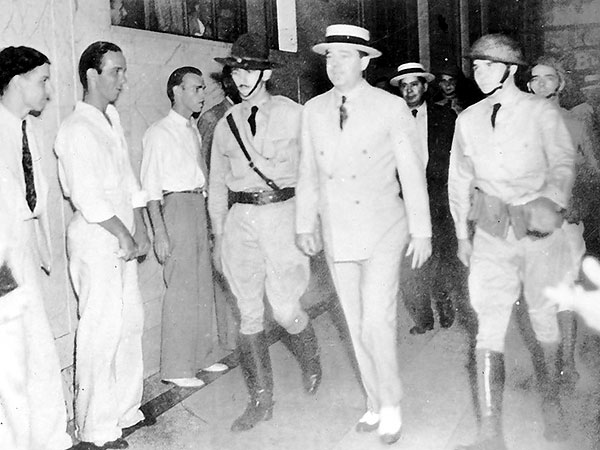Dashed Hopes (Chapter One)
"Dashed Hopes"

Mayor of Chicago Anton Cermak (left) and President-elect Franklin D. Roosevelt (right)
A crippled nation was left horrified and in a state of lamenting. The man who embodied a new hope in dire times had just been slain by an assassin's bullet. He hadn't even taken the oath of office, and yet, millions of Americans across the nation trusted his every word. In his demise left a nation in economic and political crisis, with no clear vision or path forward. As the nation reeled over this unprecedented tragedy, a new leader needed to be determined.
Mayor of Chicago Anton Cermak (left) and President-elect Franklin D. Roosevelt (right)
The line of succession made it clear the Vice President was to take over in the event of the sitting President being unable to complete the term - this had been reaffirmed in John Tyler's case almost a century ago. However, Roosevelt had not been president yet, so it became unclear who would be the one to take the oath of office in March. Immediately, the Vice-President elect, John Garner, was the immediate frontrunner, as it was believed that upon his inauguration as vice president that he would automatically assume the presidency by means of automatic succession.
However, the line of succession based on the vague 1886 law stated that in the event of both the presidency and vice presidency being vacated, the Secretary of State would become acting president, followed by various other cabinet roles, notably excluding the Speaker of the House and President pro Tempore of the Senate. The man leading the State Department was Henry Stimson, a Republican, which of course led to outrage over the fact that he had not been elected, and was representing the derided Hoover administration. Stimson, however, made things easy by relinquishing himself from the role and announcing his resignation from the Department of State upon Hoover's departure, and all other Hoover cabinet officials elected to make the same decision.
Nevertheless congress moved to an emergency session on February 18th to establish a new, firm line of succession, amending it to make the Speaker of the House the front of the line of succession upon a double vacancy. The new law also ruled that precedent would be expanded to include an absence in President and Vice-President-elects upon a double vacancy prior to taking office. Both of these amendments placed Garner in line immediately as the new President-elect.

John Nance Garner, 32nd President of the United States
Also on the agenda for Congress in 1933 was a series of amendments to the Constitution. The 20th and 21st amendments, changing the presidential inauguration date to January 20th and repealing the 18th amendment - which enacted prohibition - respectively, had already been passed in Congress, with the 20th having already been ratified entirely. Garner proved quite effective in ratifying the 21st amendment, however, as he used his status as a man from the South, a notably dry region, to drive home the narrative of prohibition being more economically harmful than any moral righteousness was worth.
Another amendment, however, was proposed in the aftermath of Roosevelt's death. With Garner's ascension to the White House, the Vice Presidency was left vacant upon the start of the term. This amendment proposed that in the event of any future vice-presidential vacancies, the President could nominate an interim Vice President to serve the remainder of the term, whom would then be voted on by both houses of congress to confirm the nomination. This amendment would too pass with little issue, being officially ratified on January 19th, 1934.
Upon the 22nd amendment's passage, Garner began his search for his second-in-command. His criteria was fairly simple: someone he could work with and influence. His choice, was also pretty simple. William Gibbs McAdoo was a man with great tenure, having served as Woodrow Wilson's right hand man for much of his presidency, attempting to run for president himself in the 20s, before becoming a major party power broker. More importantly, however, was his working relationship with Garner. McAdoo had helped him secure California's delegates at the 1932 DNC, and played a pivotal role in securing his spot on the ticket in the election that got him here in the first place. No matter how much William Randolph Hearst would deplore the decision, Garner was steadfast in his call. McAdoo was experienced, loyal, and was going to be Garner's vice president.

William Gibbs McAdoo, 32nd Vice President of the United States
:max_bytes(150000):strip_icc()/striking-at-chevrolet-plant-678138941-59ac64dcd963ac0011802ae1.jpg)



